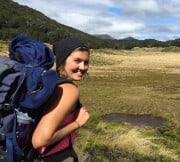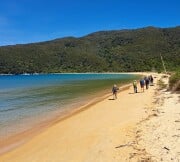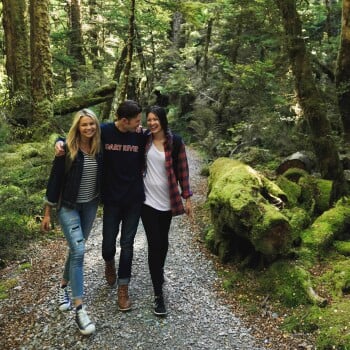- About Us
-
Trips
-
 Kiwi-Style Hiking
Kiwi-Style Hiking
-
 Great Walks
Great Walks
-
 Hiking Tours
Hiking Tours
-
Alpine Hikes
-
Custom Groups
- Huayhuash Trek
- Family Northern Explorer
- Family Southern Explorer
- Lake Waikaremoana Hike
- Women's Custom Tours
- Women's Southern Wilderness
- Coast, Canyons and Mountains
- Coastal Wanderer Custom Tour
- Don't Cross the Ladies
- Secret South Custom Tour
- Tekapo Hike
- West Coast Custom Tour
- World Heritage Custom Tour
-
- Blog
- Shortlist
- About Us
- Trips
- Blog
- Shortlist

Sep 18, 2024
It’s difficult to adequately describe the intrinsic joy of staying in a hut. It’s a privilege, a delight and a singular experience. Our backcountry huts are a quintessentially Kiwi symbol of egalitarianism. It doesn’t matter who you are, or where you’re from, huts are more than just shelter, they’re are social hubs, life-saving refuges, an escape from civilization or an adventure for families and friends, a place where people from all walks of life share space, time, stories and cups of tea.
A brief history
New Zealand has the largest network of backcountry huts in the world, accessed by nearly 15000km of public trails, the almost 1000 huts along these tracks are managed by the Department of Conservation and maintained with invaluable input from the Backcountry Trust, Federated Mountain Clubs and enthusiastic individuals with personal interests in the huts.
Backcountry huts are entrenched in the culture and history of Aotearoa, without which, the story of our past and present could not be told. Huts evolved through varying early uses, firstly by travelling Māori as shelter from the elements, then gold miners, pioneering explorers, mappers and land surveyors, and later, stock musterers and hunters. Introduced deer and other pests like Himalayan tahr and chamois caused ecological devastation in the early 20th century, which brought hunters into the backcountry to build or repair huts to live in while they hunted deer in exchange for payment from the government. Early shelters made way for bigger huts which were then used by hikers, climbers, mountaineers and other backcountry users in the more recent past.
You’ll find huts perched on lonely hillsides, on beach fronts, hidden in thick forest, or atop glaciers, in the night you can listen to nearby the ice shelves cracking and groaning under their own weight.

What will you find in a hut?
Maybe nothing. The most basic huts would be lucky to even be called by such a name, but for the weary traveler arriving at their hut/shelter/bivouac (or, bivvy, as we kiwis call them) at the end of the day, there is no more welcome sight. Most huts offer basic services, like a water tank, fireplace and firewood. All huts have basic bunks, and maybe even a long-drop or composting toilet.
The more popular routes offer serviced huts (mainly on the Great Walks) have multiple bunk rooms (but no bed linen, bring your sleeping bag), some cooking facilities (but not utensils), running cold water (but not showers) and are managed by live-in hut wardens who are there to offer information, help maintain the facilities and be a point of contact for any issues on the tracks. There is no power (although some Great Walks Huts are lit with solar lighting) and no WIFI in huts, so you’ll need to be prepared to go without, but that’s not necessarily a bad thing, consider the enjoyment of being able to truly switch off.
Know before you go. If you’re planning to hike in Aotearoa New Zealand’s backcountry, check the Department of Conservation website for what is available at the hut you're heading to.
Hut happiness
Even in the smallest of huts, you’ll find plenty of things to look at, inspect, observe and enjoy, often things you wouldn’t look twice at in the outside world; things left behind, sometimes on purpose, sometimes by accident, trinkets, old bottle caps, bent forks or notes. I’ve read some insightful graffiti on bunks, enjoyed some very old magazines, and even taken the occasional book to read, which I’d leave in the hut for the next occupant, it’s like a rotating library for hikers. Even the hut visitors/intentions book makes for interesting reading.
If you’re travelling from overseas and using backcountry huts, it’s not uncommon to come across hunters, New Zealand’s unsung conservation heroes, who also base themselves out of backcountry huts. There’s a strong chance the hut you stay in is there because of hunters. While deer and other pest numbers have been reduced in this country since their peak in the 1950s, hunting remains a common pastime for people hunting trophy animals, escaping the hustle and bustle, or simply feeding their families. I have spent many nights in huts while looking for trophy animals or dinner myself. If you’re really lucky, and have the inclination, a hunter might even share some of their meat with you. I recommend trying tahr if you can, it's delicious. Chamois, not so much…

Hut Etiquette
Everyone who’s stayed in a hut has a story of poor etiquette they’ve experienced, some stories are funny, some are flat-out deplorable, ranging from very loud snorers to stolen food and wasted water. Being respectful of other people in huts is paramount. Being welcomed into a hut with an “I’ll put the billy on” is enough to melt even the chilliest of fingers, or hearts. If staying in a hut that isn’t available to book, expect to squeeze up and make room for others, or experienced hikers who bring tents, camp outside and let the family group that arrived last have the bunks.
It’s simple really, keep your own things tidy, be considerate of other people’s things, pick up after yourself, take your rubbish with you, come prepared, and leave the hut tidy for the next user. Make sure you sign the hut book with your intentions, so there’s a record of where you’re off to next. It’s for yours and others’ safety. Remember, huts are a shared space for everyone and are therefore a shared experience.
Booking huts
More popular hikes, like the Great Walks require spaces in huts to be booked, and are often booked out up to a year in advance. If you wish, you may like to take a tent and camp at campsites, or next to a hut. If you don’t book a hut (not all huts are available to be booked), you may find the hut full and you’ll need to camp nearby, bear in mind, campsites also need to be booked on the Great Walks, if you arrive without a booking, the hut warden will ensure you pay!
Huts that are not available to be booked tend to be less busy, and offer you an authentic, slightly rougher but cup-filling experience like no other.
Leave your troubles behind, immerse yourself in the absolute wilderness of the backcountry, be part of our rich history and experience the magic of the outdoors, left for you by explorers past.

Words by Anna Morris







